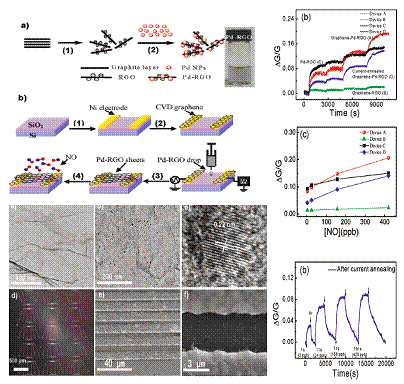Graphene is a 2-dimensional (2D) nano-material with an one-atom-thick planar sheet of sp2-bonded carbon atoms. Its large specific surface and high carrier mobility enable graphene to be a promising application in electricity-based sensors. Nitric oxide (NO) detection plays an essential role in medical applications for its biological functions as a messenger molecule. NO molecules can mediate many bodily functions acting as a neurotransmitter and relaxing blood vessels. The detection of NO is critical for an asthma patient in a hospital and with household monitoring.
Recently, Prof. LIU Liwei's team from Suzhou Institute of Nano-Tech and Nano-Bionics (SINANO), CAS, cooperating with the Institute of Physics, has successfully developed the graphene-based sensing devices fabricated by alternating current dielectrophoresis (ac-DEP) for highly sensitive nitric oxide (NO) gas detection. The novel device comprises the sensitive channels of palladium-decorated reduced graphene oxide (Pd-RGO), which is based on the controllable preparation of reduced graphene oxide (Advanced Materials 22,638(2010)). The electrodes covered with chemical vapor deposition (CVD)-grown graphene are used to improve the contact. The highly sensitive, recoverable, and reliable detection of NO gas ranging from 2 to 420 ppb with response time of several hundred seconds has been achieved at room temperature. The facile and scalable route for the high performance suggests a promising application of graphene devices toward the human exhaled NO and environmental pollutant detection.This work has been published on ACS nano 5, 6955 (2011).
The work was supported by National Natural Science Foundation of China, and Suzhou Science and Technology Development Plan. The project also got assistance from the Nanofabrication Facility and Platform of Characterization & Test of SINANO.
 |
|
Figure1. The structure and performance of the highly sensitively graphene-based sensor
Image by SINANO |

